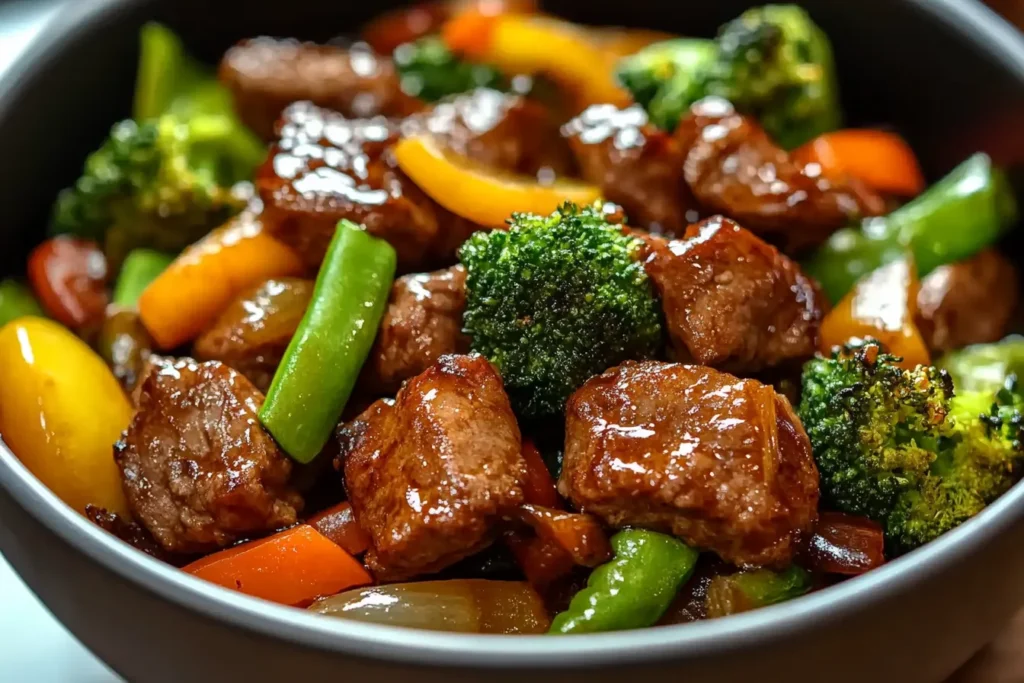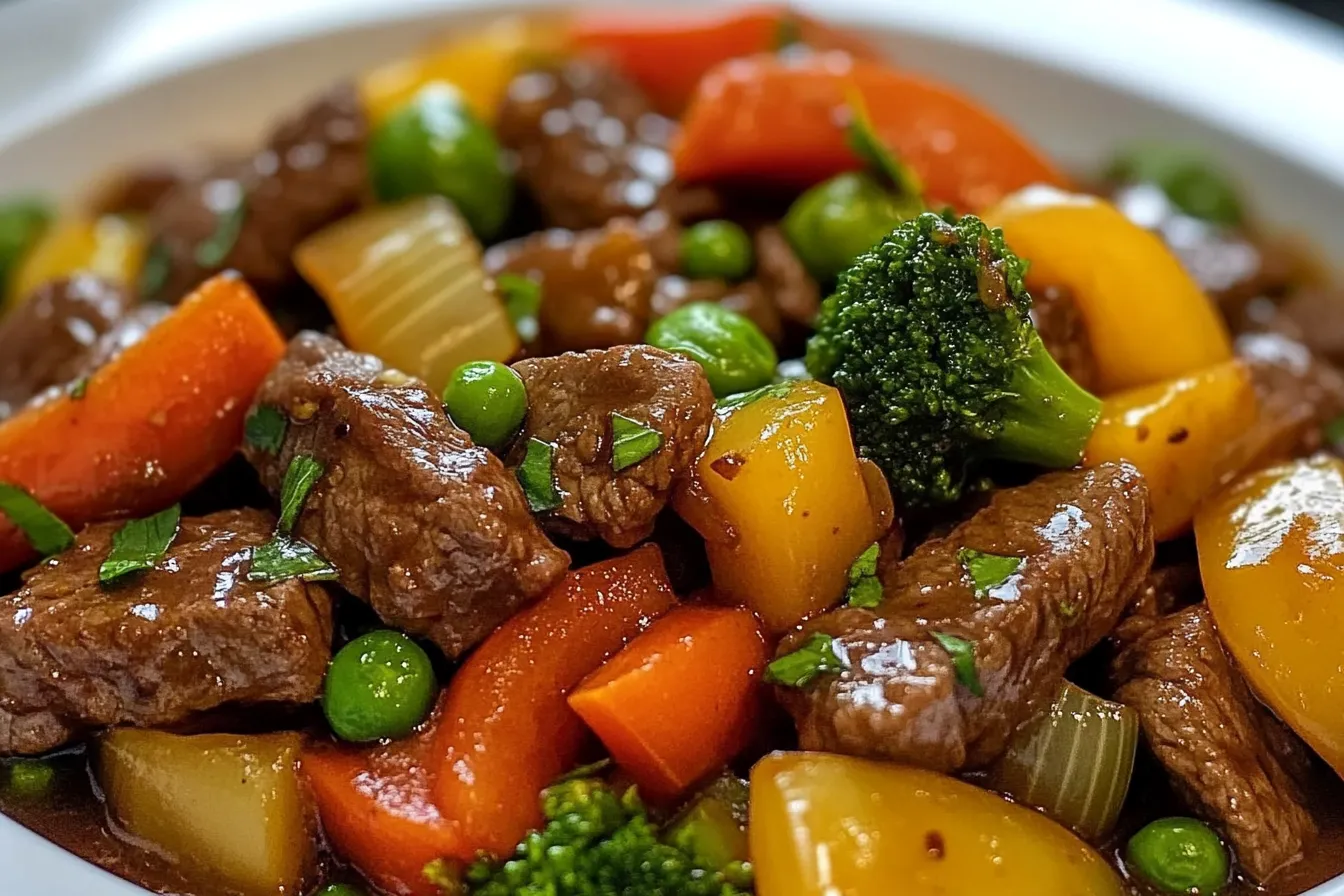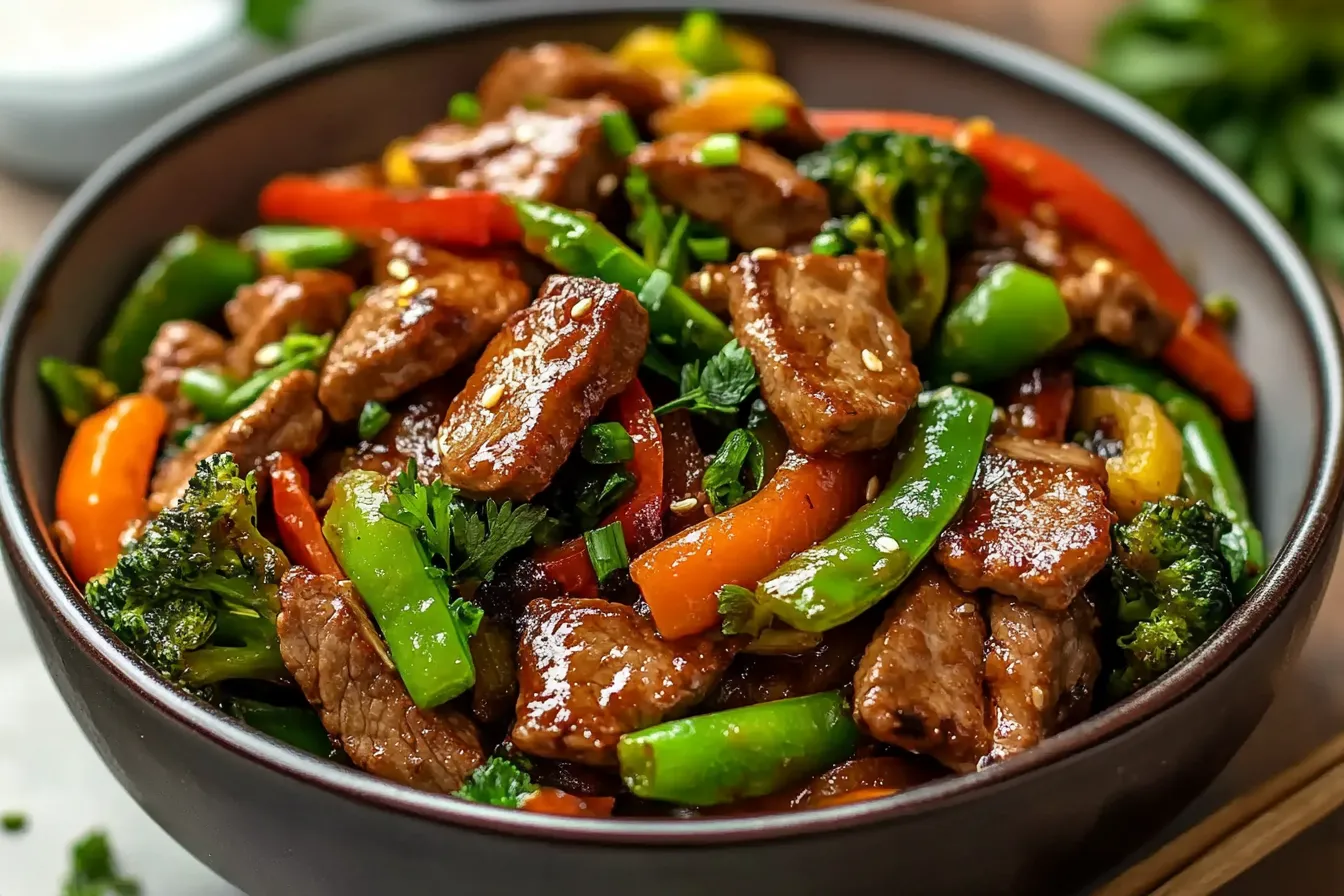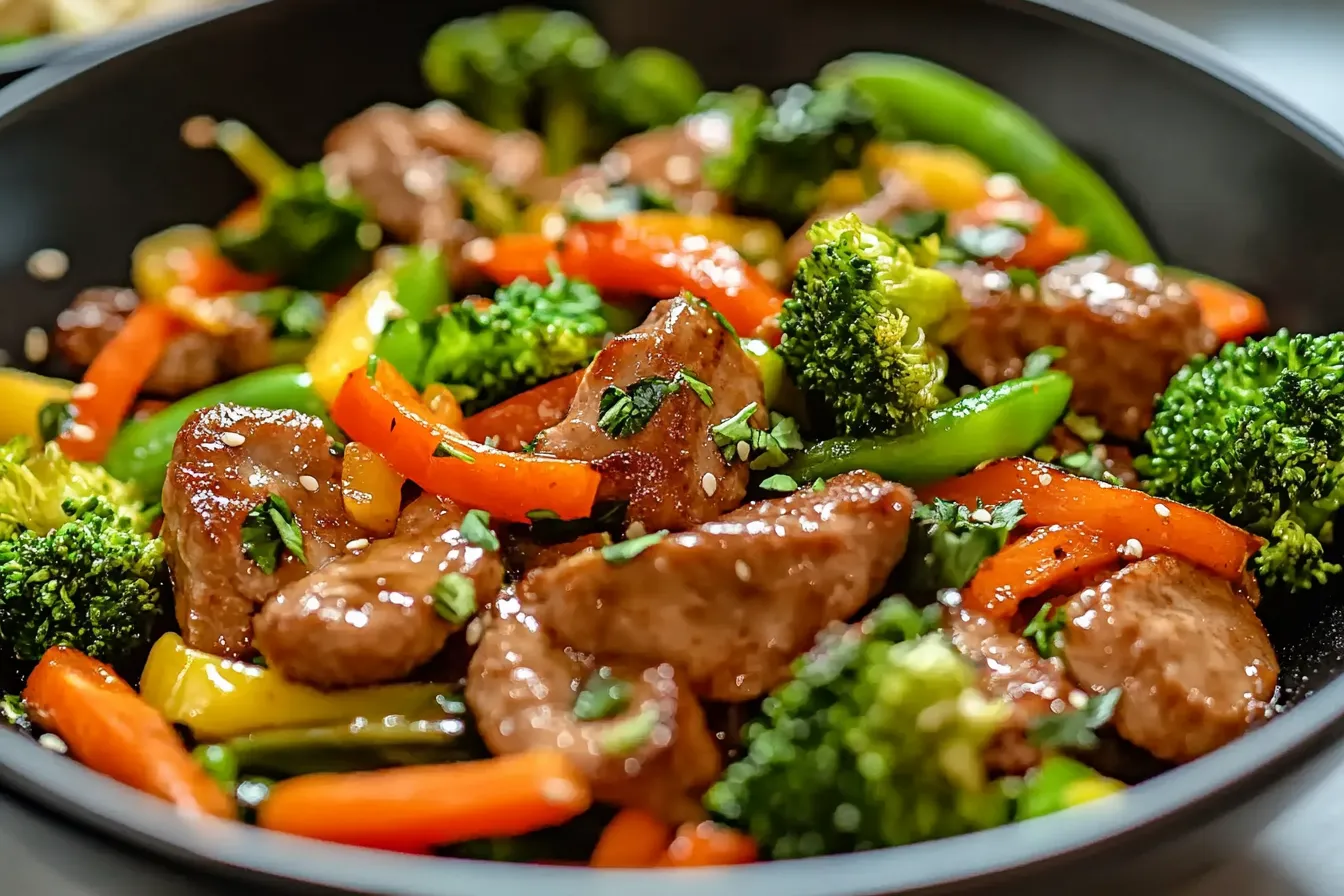What is the secret to a good stir fry, stir-frying is a key cooking method in Chinese cuisine. It quickly cooks ingredients together, creating a delicious dish. This guide will help you make stir-fries that taste like they’re from China.
For a great stir-fry, use high heat and cook fast. This keeps the ingredients’ flavors, colors, and textures fresh. It’s important to prepare ingredients well, manage the heat, and use the right sauces and seasonings.”secret”
Key Takeaways
- Stir-frying is a fundamental cooking technique in authentic Chinese cuisine.
- Mastering stir-frying unlocks a world of bold flavors, vibrant textures, and the essence of traditional Chinese culinary traditions.
- High heat and lightning-fast cooking are the keys to preserving the natural flavors, colors, and textures of the ingredients.
- Proper ingredient preparation, heat management, and the right blend of sauces and seasonings are essential elements in perfecting the art of stir-frying.
- Exploring the cultural significance and regional variations of stir-frying can deepen your appreciation for this iconic cooking technique.
Essential Equipment for Authentic Chinese Stir Frying
To master Chinese stir frying, you need the right tools. This includes picking the perfect wok and getting the right utensils. Having the right equipment is key to making great stir fries and getting that special wok hei flavor.
Choosing the Perfect Wok
The wok is the heart of Chinese cooking. When picking a wok, think about the material and shape you need. Carbon steel woks heat up fast and get a nonstick surface over time. Cast iron woks keep heat well and are great for high heat.”secret”
Look for a wok that’s wide and sloping. This shape helps you toss and stir ingredients easily.
Must-Have Utensils and Tools
- Wok spatula: A long, strong spatula is key for tossing ingredients.
- Strainer or spider: This tool helps remove cooked items from the wok, ensuring even cooking.
- Cleaver: A sharp Chinese cleaver is needed for cutting ingredients evenly.
- Measuring cups and spoons: Accurate measurements are crucial for stir fry sauces and marinades.
Heat Source Requirements
You need a strong heat source for wok hei flavor. Gas stoves with strong burners are best for stir frying. If you have an electric or induction cooktop, choose one with high-BTU output for intense heat.”secret”
| Wok Material | Pros | Cons |
|---|---|---|
| Carbon Steel |
|
|
| Cast Iron |
|
|
Investing in the right equipment is crucial for mastering Chinese stir frying. With a good wok, essential utensils, and a strong heat source, you can make delicious stir fries at home. You’ll be able to create dishes that taste like they’re from a restaurant.”secret”
What is the Secret to a Good Stir Fry
The secret to a perfect stir fry is a mix of high heat, careful ingredient prep, and perfect timing. To get the wok hei – that special “breath of the wok” flavor – you need to learn stir fry techniques.
First, the wok temperature is key. Turn the heat up high to make the wok extremely hot. This heat sears and caramelizes the ingredients, keeping their flavors locked in. It’s also important to prepare your ingredients well before cooking, (the secret to a good stir fry).
- Cut proteins, veggies, and aromatics into small, even pieces for even cooking.
- Marinate proteins in a tasty sauce to make them tender and flavorful.
- Have all your sauces and seasonings ready and within reach for quick use.
With the wok hot and ingredients ready, timing is the last step. Stir frying is a quick dance, where you add ingredients in the right order and cook them just right. This way, you get the perfect mix of textures and flavors in your stir fry.”secret”
“The secret to a good stir fry is in the preparation of the ingredients, the temperature of the wok, and the timing of the cooking process.”
By mastering these stir fry techniques, controlling the wok temperature, and preparing your ingredients well, you’ll make stir fries at home that taste like they’re from a restaurant.
Mastering the Art of Ingredient Preparation
Making a perfect stir-fry is more than just tossing ingredients in a hot wok. It’s about getting the right mix of flavors and textures. This starts with how you prepare your ingredients, from cutting to marinating.”secret”
Proper Cutting Techniques
How you cut your veggies and meat matters a lot in stir-fries. You want pieces that cook evenly and feel good in your mouth. Here are some tips for vegetable cutting techniques:
- Julienne: Cut veggies into thin strips for a light feel.
- Diagonal slice: Slice at a 45-degree angle for a cool look.
- Bite-sized chunks: Chop veggies into even pieces for even cooking.
Marinating Tips for Maximum Flavor
Marinating your meat for stir-fry adds a lot of flavor. Try different marinades like soy sauce, rice vinegar, or ginger and garlic. Let your meat marinate for at least 30 minutes, or even longer for more flavor.”secret”
Vegetable Preparation Guidelines
Vegetables are key in stir-fries. To keep them colorful and crunchy, follow these tips:
- Wash and dry all veggies to remove moisture.
- Cut veggies into the same size for even cooking.
- Parboil hard veggies like broccoli or carrots to start cooking.
- Add soft greens like bok choy or spinach at the end to avoid overcooking.
By getting good at preparing ingredients, you’ll make your stir-fries even better. You’ll get a mix of flavors and textures in every bite.”secret”
Understanding Wok Hei: The Breath of the Wok
In Chinese cooking, “wok hei” is a term loved by many. It’s called the “breath of the wok.” This flavor comes from cooking at high heat and using the right techniques.
Wok hei happens when food is tossed and seared at very high temperatures in a seasoned wok. This heat sears the food and caramelizes sugars. It creates a smoky, umami-rich taste that’s key to real Chinese stir-fries.
To get wok hei, cooks need to season their woks well and manage heat carefully. A seasoned wok helps food cook fast, creating a delicious char and that special “breath of the wok” flavor.
Getting the perfect wok hei takes timing and temperature control. Cooks must add ingredients in the right order and at the right time. If the heat is off, the dish loses its wok hei flavor.”secret”
“The true essence of Chinese cooking lies in the perfect balance of high-heat searing and the resulting wok hei flavor.”
By learning wok hei techniques, home cooks can make authentic Chinese high-heat cooking in their own kitchens. With practice and knowledge of Chinese cooking techniques, they can capture the “breath of the wok” in every stir-fry.
Essential Stir Fry Sauce Combinations
Making the perfect stir fry is more than just cooking. The sauce is the heart of a great stir-fry. Learn the key stir fry sauce combinations to take your Chinese cooking to the next level.
Basic Sauce Ratios
The right sauce ratio is key for a balanced stir fry. Remember the 3-2-1 formula: 3 parts soy sauce, 2 parts rice vinegar or broth, and 1 part sugar or honey. You can tweak this to match your taste and the dish you’re making.”secret”
Regional Chinese Sauce Variations
Chinese cuisine is known for its varied flavors, and stir fry sauces are no different. Let’s dive into the unique tastes of different regions:
- Sichuan: Spicy and numbing, with Sichuan peppercorns and chili oil.
- Cantonese: Light and delicate, with oyster sauce, sesame oil, and white pepper.
- Hunan: Fiery and bold, with fermented chili bean paste and Shaoxing wine.
- Zhejiang: Aromatic and slightly sweet, with rice vinegar and ginger.
Thickening Techniques
The sauce’s consistency is important for the right feel and coating. Here are some thickening methods:
- Cornstarch: Make a slurry of cornstarch and water, then add it slowly while simmering.
- Arrowroot: Use arrowroot powder for a glossy, translucent sauce.
- Egg whites: Add a few beaten egg whites at the end for a silky texture.
Understanding stir fry sauce basics and exploring China’s regional flavors will help you make amazing stir-fries. You’ll show off your cooking skills with every dish (the secret to a good stir fry).
Protein Preparation Techniques for Perfect Results
Getting proteins ready right is crucial for a great stir-fry. Whether you’re marinating meat or keeping shrimp juicy, a few tricks can help a lot.
“Velveting” is a method to tenderize meat. It involves blanching the meat in a tasty liquid, then stir-frying it. This makes the meat silky and tender, just like in Chinese dishes. Marinating meat for stir fry also boosts flavor and keeps it moist.”secret”
For shrimp, soaking them in milk before frying is a good tip. This makes the shrimp tender and sweeter. Then, fry them in a wok over high heat, tossing them fast to avoid overcooking (the secret to a good stir fry).
Vegetarian options like tofu and tempeh also need smart prep. Pressing tofu removes excess water, making it sear well. Tempeh, with its nutty taste, can be marinated or simmered before stir-frying.
“The key to perfect stir-fried proteins is all in the prep work. Taking a few extra minutes to properly prepare your ingredients will ensure they cook up tender, juicy, and full of flavor.”
Choosing the right proteins and preparing them well can make your stir-fry amazing.”secret”
Temperature Control and Timing in Stir Frying
Mastering stir-frying means controlling temperature and timing well. The three main rules are high heat, constant stirring, and quick cooking. These rules help you get that smoky, wok-charred flavor known as wok hei.”secret”
Heat Management Tips
Getting the wok temperature right is crucial. Start with a very hot wok to sear and caramelize ingredients fast. Keep the heat high while cooking, adjusting as needed to avoid burning. Here are some tips for managing heat:
- Preheat your wok for at least 2-3 minutes before adding oil.
- Use a wok that conducts heat well, like carbon steel or cast iron.
- Adjust the heat source as you add ingredients to keep the wok temperature consistent.
Cooking Sequence Guidelines
The order of adding ingredients to the wok matters a lot. Here’s a general sequence for great results:
- Add oil and let it heat up until it just starts to smoke.
- Stir-fry the aromatics (garlic, ginger, etc.) for 30 seconds to 1 minute.
- Add the protein and stir-fry until it’s about 80% cooked.
- Toss in the vegetables and stir-fry until they’re crisp-tender.
- Finally, add the sauce and any remaining ingredients, and stir-fry until everything is heated through.
Common Temperature Mistakes
Avoid these common temperature mistakes in stir-frying:
- Starting with a wok that’s not hot enough, leading to steamed, soggy vegetables.
- Overcrowding the wok, which can cause the temperature to drop dramatically.
- Repeatedly lifting the lid or stirring too slowly, which allows heat to escape.
By following these tips and guidelines, you’ll master wok temperature control and stir fry timing. This will help you follow the 3 rules of stir-frying and achieve that coveted wok hei.”secret”
Seasoning and Aromatics: Building Layers of Flavor
Improving your stir-fry dishes starts with seasoning and using aromatic ingredients. Chinese food is famous for its deep flavors. You can achieve this by layering Chinese aromatics and stir fry seasonings during cooking.
The key to a great stir-fry is the trio of ginger, garlic, and scallions. These strong ingredients are the base for flavor layering techniques. Start by mincing or grating them and adding them at key moments. This releases their fragrance and rich flavors (the secret to a good stir fry).
- Ginger adds a warm, slightly spicy note that brightens the dish.
- Garlic lends its characteristic savory and slightly sweet essence.
- Scallions provide a subtle onion-like flavor and vibrant green color.
Explore Chinese stir fry seasonings to add more layers of flavor. Soy sauce, oyster sauce, and five-spice powder are key. Mix them to create complex tastes. Find the right mix of sweet, salty, and umami to make your stir-fries stand out.”secret”
“The secret to a great stir-fry lies in the perfect marriage of aromatics and seasonings.”
The secret to amazing stir-fries is using the right Chinese aromatics and stir fry seasonings. Mastering flavor layering techniques will help you make authentic and tasty Chinese dishes at home.
Troubleshooting Common Stir Fry Problems
Mastering stir-frying takes time and practice. But with the right techniques, you can solve common problems and get great results. Let’s look at some common issues and how to fix them.”secret”
Preventing Soggy Vegetables
For a great stir fry, veggies should be crisp and flavorful. To avoid soggy veggies, cook them in small batches and keep the heat high. Don’t overcrowd the wok, as it can steam instead of sear.
Also, dry your veggies well before adding them to hot oil.
Fixing Sauce Issues
Getting the sauce right in stir fry can be tricky. If your sauce is too thick, add a bit of broth or water. If it’s too thin, mix in a cornstarch slurry to thicken it.
Taste and adjust the seasoning. Add more soy sauce, rice vinegar, or other flavorings to get it just right.
Temperature Management Solutions
Controlling the temperature is key in stir-frying. If your ingredients burn or get overcooked, your wok is too hot. Lower the heat and add more oil to help control it.
If your ingredients take too long to cook or get soggy, your wok is too cold. Turn up the heat and let the wok preheat fully before adding your ingredients.
FAQ
What are the 3 rules of stir-frying?
Stir-frying has three key rules. First, use high heat. Second, stir and toss the ingredients constantly. Third, cook the dish quickly. These steps help get the wok hei flavor right and keep the ingredients crisp.
Why do you soak shrimp in milk before frying?
Soaking shrimp in milk before frying makes them better. The milk tenderizes the shrimp and removes bad flavors. This makes the shrimp sweeter and more tender.
How do you fry shrimp in a wok?
To fry shrimp in a wok, start by heating it over high heat until it smokes. Then, add a bit of oil and swirl it to coat the wok.
Next, add the shrimp in a single layer. Let them sear for 30 seconds to 1 minute. After that, toss and stir-fry the shrimp until they’re fully cooked, about 2-3 minutes.
Take the shrimp out of the wok and set them aside. Then, finish your stir-fry recipe. Add the shrimp back in at the end to warm them up.




